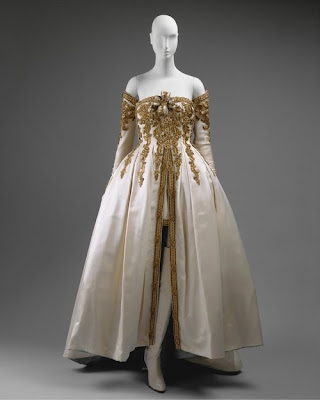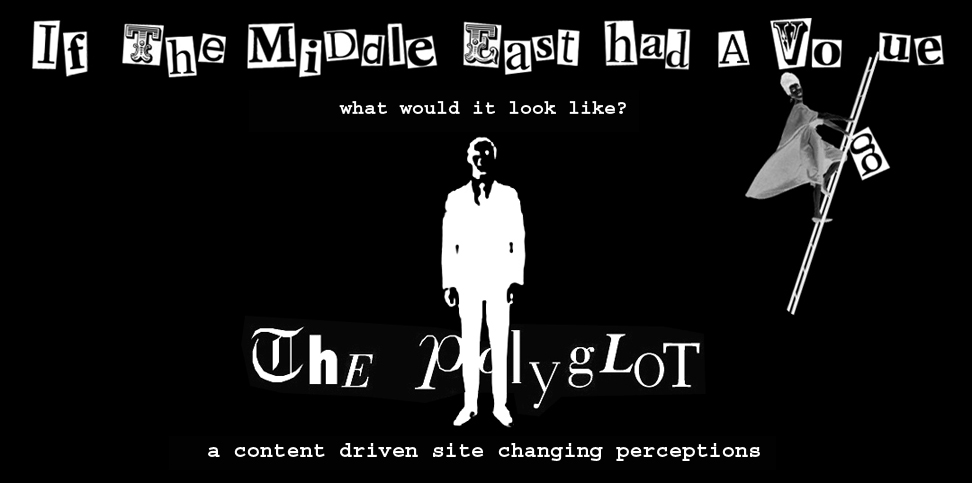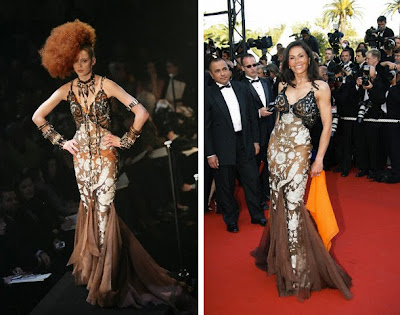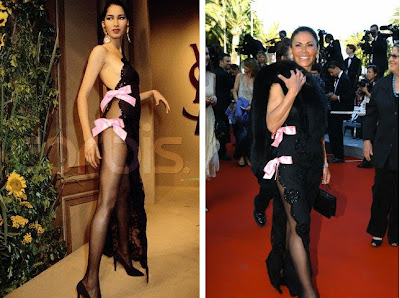Recent loans by a legendary couture client are reshaping the fashion exhibit as we know it
 Mouna Ayoub in a Gaultier fur wrap from Fall 1998
Mouna Ayoub in a Gaultier fur wrap from Fall 1998
Despite being M.I.A. for the past couple of seasons, Lebanese couture client Mouna Ayoub, is still said to have one of the largest collections of haute couture in private hands today. Numbering in the thousands, it was acquired over a 30 year period and boasts examples by some of Paris’ most storied fashion houses. What makes Ayoub’s collection unique from a curatorial perspective is her ability to pick the most iconic looks from a couturier’s collection, as well as the fact that she rarely altered the original design (a rarity amongst clients).
Recently Ayoub’s name has resurfaced in a series of high-profile fashion exhibitions. It began last summer with a retrospective of Yves Saint Laurent’s work in Paris. On display, in a section devoted to the couturier’s most loyal clients, was an iconic one-shouldered evening gown, fastened on one side by two pink satin bows. Ayoub purchased the piece from the designer’s spring 1991 couture collection.
 Although Ayoub kept most of her couture purchases, she donated this Chanel couture evening gown from Fall 1990, to the Met’s costume collection.
Although Ayoub kept most of her couture purchases, she donated this Chanel couture evening gown from Fall 1990, to the Met’s costume collection.
To be sure, Saint Laurent has long enjoyed a following amongst the Middle East’s best dressed women; amongst them couture connoisseurs Farah Diba, Princess Firyal of Jordan and Princess Haifa Al Faysal of Saudi Arabia. Until he shuttered his couture business in 2002, the designer dressed three generations of women from the region, including mothers, daughters and granddaughters. Despite this, Ayoub is still considered couture’s most visible Middle Eastern patron.
In December 2010, she was amongst a string of high-profile clients to lend their jewels for the blockbuster Bulgari exhibit in Paris. Held at the Grand Palais, the glittering show featured rare pieces concocted by the Roman jeweler for the likes of Elizabeth Taylor, the Begum Aga Khan and Lyn Revson, the wife of Revlon founder Charles Revson.
 Mouna Ayoub in a Gaultier fur wrap from Fall 1998
Mouna Ayoub in a Gaultier fur wrap from Fall 1998Despite being M.I.A. for the past couple of seasons, Lebanese couture client Mouna Ayoub, is still said to have one of the largest collections of haute couture in private hands today. Numbering in the thousands, it was acquired over a 30 year period and boasts examples by some of Paris’ most storied fashion houses. What makes Ayoub’s collection unique from a curatorial perspective is her ability to pick the most iconic looks from a couturier’s collection, as well as the fact that she rarely altered the original design (a rarity amongst clients).
Recently Ayoub’s name has resurfaced in a series of high-profile fashion exhibitions. It began last summer with a retrospective of Yves Saint Laurent’s work in Paris. On display, in a section devoted to the couturier’s most loyal clients, was an iconic one-shouldered evening gown, fastened on one side by two pink satin bows. Ayoub purchased the piece from the designer’s spring 1991 couture collection.
 Although Ayoub kept most of her couture purchases, she donated this Chanel couture evening gown from Fall 1990, to the Met’s costume collection.
Although Ayoub kept most of her couture purchases, she donated this Chanel couture evening gown from Fall 1990, to the Met’s costume collection.To be sure, Saint Laurent has long enjoyed a following amongst the Middle East’s best dressed women; amongst them couture connoisseurs Farah Diba, Princess Firyal of Jordan and Princess Haifa Al Faysal of Saudi Arabia. Until he shuttered his couture business in 2002, the designer dressed three generations of women from the region, including mothers, daughters and granddaughters. Despite this, Ayoub is still considered couture’s most visible Middle Eastern patron.
In December 2010, she was amongst a string of high-profile clients to lend their jewels for the blockbuster Bulgari exhibit in Paris. Held at the Grand Palais, the glittering show featured rare pieces concocted by the Roman jeweler for the likes of Elizabeth Taylor, the Begum Aga Khan and Lyn Revson, the wife of Revlon founder Charles Revson.
That 60 percent of the Bulgari show was made up of private loans, points to a new trend in the luxury industry. Brands are increasingly competing with museums to augment their own archives and put on shows. Back in 1994, Bulgari hired curator Amanda Tiossi to manage its archives, which includes buying back pieces that represent milestones in the jeweler’s history. A challenging task, considering clients such as Mouna Ayoub and Monaco’s Grimaldi family, are still hanging onto their jewels.
More recently, Mouna Ayoub’s name has been linked to “The Idealized History of Fashion,” exhibit currently being held at Paris’ Musée des Arts Décoratifs. Exploring the evolution of fashion from 1990 to the present, the exhibition boasts an impressive number of pieces from Ayoub’s own couture collection.
More recently, Mouna Ayoub’s name has been linked to “The Idealized History of Fashion,” exhibit currently being held at Paris’ Musée des Arts Décoratifs. Exploring the evolution of fashion from 1990 to the present, the exhibition boasts an impressive number of pieces from Ayoub’s own couture collection.
Its curator, Olivier Saillard, is considered a rising star in the field. He will head Paris’ newly restored Musée Galliera. Boasting one of the largest costume collections in the world, the museum will unveil a major retrospective of Madame Grès later this year.
Yet despite such clout, even Saillard had a hard time convincing fashion houses to lend him pieces for the show. “Heritage” has become the buzzword amongst luxury labels, looking to assert themselves in an increasingly saturated (and diluted) luxury market. As a result costume curators must now compete with fashion executives, to not only acquire pieces for their archives, but also put on shows.
 Mouna Ayoub in Gaultier Paris, Spring 2000
Mouna Ayoub in Gaultier Paris, Spring 2000
To “make room,” Saillard borrowed several pieces from Mouna Ayoub’s haute couture collection to fill gaps throughout the exhibition. Amongst these items is a gilded evening jacket from Chanel’s fall 1996 couture collection, which took the Lesage workshops 800 hours to complete.
That Ayoub also lent a number of iconic pieces by Gaultier, is an irony not lost on many in the industry, when up until two decades ago most designers had to rely on a client’s generosity to put on their own retrospectives. Now it seems museums must do the same in order to compete with archivists focused on a brand’s image.
Yet despite such clout, even Saillard had a hard time convincing fashion houses to lend him pieces for the show. “Heritage” has become the buzzword amongst luxury labels, looking to assert themselves in an increasingly saturated (and diluted) luxury market. As a result costume curators must now compete with fashion executives, to not only acquire pieces for their archives, but also put on shows.
Amongst fashion houses, the “costume exhibit” has become the new marketing tool and some are taking the concept one step further. Later this year Gucci will inaugurate its own museum in Florence. In an interview with Suzy Menkes, Saillard summed up the mood amongst curators, “We are in a very delicate situation. The houses want to make exhibitions to the glory of their names, across the world and particularly in China. A show can be done on a reasonable budget and it can garner a lot of publicity. It doesn’t leave much room for us.”
 Mouna Ayoub in Gaultier Paris, Spring 2000
Mouna Ayoub in Gaultier Paris, Spring 2000To “make room,” Saillard borrowed several pieces from Mouna Ayoub’s haute couture collection to fill gaps throughout the exhibition. Amongst these items is a gilded evening jacket from Chanel’s fall 1996 couture collection, which took the Lesage workshops 800 hours to complete.
That Ayoub also lent a number of iconic pieces by Gaultier, is an irony not lost on many in the industry, when up until two decades ago most designers had to rely on a client’s generosity to put on their own retrospectives. Now it seems museums must do the same in order to compete with archivists focused on a brand’s image.










No comments:
Post a Comment